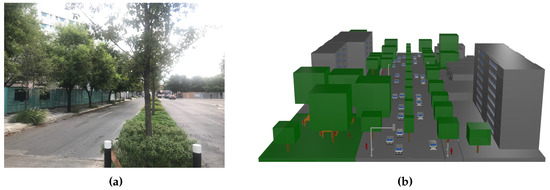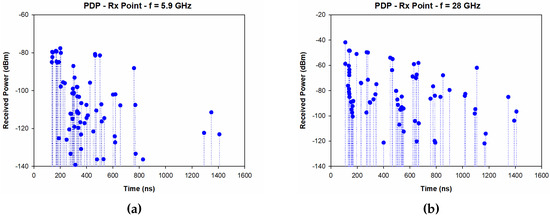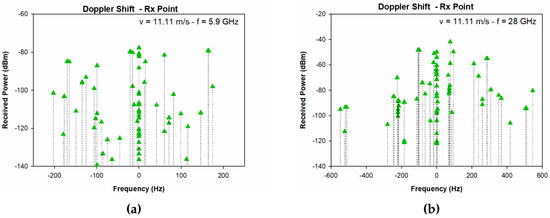Abstract
With the growing demand of vehicle-mounted sensors over the last years, the amount of critical data communications has increased significantly. Developing applications such as autonomous vehicles, drones or real-time high-definition entertainment requires high data-rates in the order of multiple Gbps. In the next generation of vehicle-to-everything (V2X) networks, a wider bandwidth will be needed, as well as more precise localization capabilities and lower transmission latencies than current vehicular communication systems due to safety application requirements; 5G millimeter wave (mmWave) technology is envisioned to be the key factor in the development of this next generation of vehicular communications. However, the implementation of mmWave links arises with difficulties due to blocking effects between mmWave transceivers, as well as different channel impairments for these high frequency bands. In this work, the mmWave channel propagation characterization for V2X communications has been performed by means of a deterministic in-house 3D ray launching simulation technique. A complex heterogeneous urban scenario has been modeled to analyze the different propagation phenomena of multiple mmWave V2X links. Results for large and small-scale propagation effects are obtained for line-of-sight (LOS) and non-LOS (NLOS) trajectories, enabling inter-data vehicular comparison. These analyzed results and the proposed methodology can aid in an adequate design and implementation of next generation vehicular networks.
1. Introduction
The concept of Smart City is so broad and relatively immature that its scope is not yet fully defined. The main motivation behind this concept comes from the efficient use of the available resources [1]. The implementation of the triad computing, communication and sensing can increase the efficiency levels significantly in several areas such as hydraulic resources, waste management, crime control, traffic management and transportation, among others. Within the different notions a Smart City should provide, Intelligent Transportation Systems (ITS) emerge as a promising idea to increase efficiency in fuel use, gas emission, route optimization and drivers’ safety.
In a world society where approximately 1.35 million people die annually in traffic-related accidents, which is the eighth leading cause of death for people of all ages and the first for people between 5 and 29 years old [2], the use of ITSs could play an important role in the solution of this critical problem. Its approach to solving this scourge is to make vehicles go beyond human deficiencies, that means, vehicles with the ability to sense their surroundings and act accordingly. To achieve these goals more sensors will be incorporated into vehicles. In fact, it is estimated that in 2020 the number of built-in sensors will reach more than 200 and that internet-integrated vehicle applications will jump to 90% by these dates [3,4,5]. The massive traffic of data produced by these sensors will require transfer rates in magnitudes of gigabits per second to communicate with other vehicles or road infrastructure. This capacity will allow bringing cloud computing to the era of autonomous driving [6]. As a consequence, the demand for wireless techniques that support this high bandwidth has increased considerably in the past years. Wireless connectivity with high transfer rates is predicted to be the next frontier in the vehicular revolution.
Both the academy and the automotive industry are exploring reliable and efficient connectivity solutions. It is in this context that vehicle-to-everything (V2X) communication performs a key role, by means of sharing and collecting knowledge between intelligent elements (i.e., another vehicle, building or traffic light). The physical layer of these links is supported by standards such as IEEE 802.11p or Dedicated-Short-Range-Communication (DSRC). While these technologies ensure low latency (less than 10 ms), their theoretical transfer rate is limited up to 27 Mbps [3,7]. Nevertheless, in recent years, significant academic activity, motivated by these requirements, has proposed the adoption of millimeter-wave (mmWave) frequencies (i.e., 10–300 GHz) to support high transfer rates and low latencies [8]. While the use of mmWave bands promises a significant increase in data rate with less latency, their use comes with a high cost of implementation. Wireless links at these high frequencies suffer from many deteriorating factors, high penetration loss, blocking and considerable path loss which pose challenges to the V2X communications. In addition to these limitations, the high medium mobility and the relatively low height of the transceivers also increase the Doppler effect phenomenon and occurrences of non-line-of-sight (NLOS). Therefore, achieving effective communication in mmWave links for vehicular environments requires a deep understanding of the vehicle communication channel, which is significantly different from those studied at frequencies below 6 GHz [8].
In this work, we present the analysis of an urban V2X mmWave link scenario using an in-house Matlab-based ray-launching (RL) algorithm [9]. The scenario description is presented in Section 2, as well as the simulation parameters for two different frequency bands. Section 3 shows the obtained results in terms of received power, power delay profile (PDP) and Doppler shift (DS). Finally, conclusions and future work are presented in Section 4.
2. Scenario Description
This section describes the scenario used to model vehicular communication through the RL algorithm. Figure 1 presents a view of the real scenario, located in a side street of Tecnológico de Monterrey, Campus Monterrey, Mexico and its rendered schematic view used for simulation. The modeled fragment corresponds to an area of approximately m which has different types of vegetation within it, such as different trees and shrubbery. The portion corresponding to the avenue occupied by the vehicles has a length of 150 m and a width of 16.5 m, where a median strip with inhomogeneous vegetation and two lanes per driving direction are included, representing a classical urban complex heterogeneous vehicular scenario. The rest of the segment shows abundant vegetation and buildings with one to eight floors.

Figure 1.
Urban scenario considered for the analysis: (a) Real view of the scenario. (b) Rendered view of the scenario.
The modeled scenario is chosen for its usefulness in terms of communication environments between urban vehicles. The presence of a median strip with abundant trees constitutes an engaging scenario for communications between vehicles on different roads. It has been considered the realism of the stage, and the placement of elements such as luminaires, traffic lights and irregular people traffic.
The transmitter has been placed above a vehicle (see Figure 2 for reference) located in the road at 1.5 m height. Two antennas have been used for the transmitter, each with 10 dBm of power. The first transmitter is a directional antenna with a beamwidth of 70 degrees, 20 dBi gain, and transmission frequency at 28 GHz. The second antenna has an omnidirectional radiation pattern with a gain of 0 dBi and a transmission frequency of 5.9 GHz. The use of different frequencies has been considered emulating the standard IEEE. 802.11p (DSRC) at 5.9 GHz and the mmWave communication at 28 GHz. Table 1 shows the different simulation parameters.

Figure 2.
Received power (dBm) at 1.5 meters height: (a) 5.9 GHz. (b) 28 GHz.

Table 1.
Ray-launching (RL) algorithm simulation parameters.
3. Results
3.1. Received Power
All the received power levels (dBm) for the complete volume of the scenario are collected using the in-house 3D-RL simulation tool. As an example, an horizontal plane at the height of 1.5 m is shown in Figure 2. Results obtained are shown at 5.9 GHz and 28 GHz frequencies, respectively. The values of received power in both planes cannot be compared to each other in numerical terms since the antenna gain differs from each other. What is noticeable is the blocking effect that occurs at higher frequencies, as it is the case of transmission at mmWave band. Communication in mmWave frequencies is greatly affected by the influence of medium and small size elements that are not commonly considered in sub 6 GHz frequencies. Specifically, the blocking effects that occur in trees and people are relevant elements to be considered in vehicular communications. All of the above in association with the use of directional communications, closely related to transmissions in the mmWave frequency bands, enhance the need to study scenarios with abundant blocking elements.
3.2. Power Delay Profile (PDP)
Power Delay Profile (PDP) is one of the most important parameters to characterize multipath propagation in complex environments. From its information, relevant parameters are derived to describe the frequency selectivity of the channel such as the root-mean-square (RMS) delay spread or the mean excess delay. Figure 3 shows the PDP for the selected frequencies (5.9 GHz and 28 GHz, respectively); the values are obtained for the receiver car located in the opposite lane of the transmitter. It can be seen that for both cases, multipath propagation is a key factor in urban environments. Specifically, it is observed that for the 28 GHz case, there is a significant contribution to the received power in the target due to multipath propagtion. The low signal penetration at mmWave frequencies results in a considerable increase in power intensity by the different paths. Multipath signals are an influential parameter in the mmWave band, and further analysis is required in the vehicular environment.

Figure 3.
Power delay profile (dBm): (a) 5.9 GHz. (b) 28 GHz.
3.3. Doppler Shift
The Doppler effect is inherent in mobile communication systems. Its direct relationship with the relative displacement of the transceivers makes it an influential factor in the characterization of wireless links. Unlike cellular systems in which the base station is static, vehicle-to-vehicle communications have mobility in both devices, which increases the complexity of the analysis. Doppler shift is also inversely related to wavelength, so it is an even more marked effect on mmWave frequency bands. Figure 4 shows the Doppler shift at the selected frequencies (5.9 GHz and 28 GHz, respectively). The analysis is performed with a constant speed in both cases of 11.11 m/s. It can be seen that the effect of Doppler shift is higher for higher frequencies, reaching up to 200 Hz at 5.9 GHz and up to 580 Hz in the 28 GHz link case. The analysis of the Doppler effect in vehicular communication increases its significance at mmWave systems, because of its relationship with the considered frequency, the relative speed of the medium and its effect on the received signal fading.

Figure 4.
Doppler shift: (a) 5.9 GHz. (b) 28 GHz.
4. Conclusions
This research analyzes some of the main characteristics of a vehicular link in a complex urban environment by means of an in-house developed 3D-RL algorithm. Two different frequency bands were analyzed, 5.9 GHz and 28 GHz. The blocking effect that occurs at mmWave frequency bands is presented. In addition, the received signal shows a marked contribution of the multipath components at both frequencies. Doppler shift was also analyzed, as it is a significant feature in communication systems with high mobility. Results obtained highlight the adverse effects that occur in the frequency shift for 5.9 GHz and 28 GHz, the latter most affected due to the reduction in wavelength. The analysis carried out, as well as the results obtained in the simulation, can lead to important considerations that need to be taken into account in order to provide proper characterization of vehicular communications in urban environments. Future work may be focused on a more extensive analysis over mmWave V2X communications, considering the blockage caused by medium and small size objects, as well as by vehicles of different dimensions and characteristics. In addition, a campaign of measurements will be performed in the real scenario, to validate the mmWave propagation channel characterization. These analyzed results and the proposed methodology can aid in an adequate design and implementation of next generation vehicular networks.
Author Contributions
F.A.R.-C., M.C.-E. and L.A. conducted the simulation and analysis of V2X channel characterization and scenario impact. P.L.-I., I.P. and F.F. conceived and prepared the wireless communication link design. A.V.-A. analyzes the vehicular propagation phenomena. F.A.R.-C. and L.A. prepared the manuscript.
Acknowledgments
The authors would like to acknowledge the support and collaboration of the School of Engineering and Sciences at Tecnologico de Monterrey.
Conflicts of Interest
The authors declare no conflict of interest. The statements made herein are solely the responsibility of the authors.
References
- Routray, S.K.; Sarangi, S.K.; Javali, A. Smart Cities: The Hopes and Hypes. arXiv 2019, arXiv:1907.05702. [Google Scholar]
- World Health Organization. Global Status Report on Road Safety 2018: Summary; Technical Report; World Health Organization: Geneva, Switzerland, 2018. [Google Scholar]
- Lu, N.; Cheng, N.; Zhang, N.; Shen, X.; Mark, J.W. Connected vehicles: Solutions and challenges. IEEE Internet Things J. 2014. [Google Scholar] [CrossRef]
- Tassi, A.; Egan, M.; Piechocki, R.J.; Nix, A. Modeling and Design of Millimeter-Wave Networks for Highway Vehicular Communication. IEEE Trans. Veh. Technol. 2017, 66, 10676–10691. [Google Scholar] [CrossRef]
- Wang, X.; Kong, L.; Kong, F.; Qiu, F.; Xia, M.; Arnon, S.; Chen, G. Millimeter wave communication: A comprehensive survey. IEEE Commun. Surv. Tutorials 2018, 20, 1616–1653. [Google Scholar] [CrossRef]
- Martin-Vega, F.J.; Aguayo-Torres, M.C.; Gomez, G.; Entrambasaguas, J.T.; Duong, T.Q. Key technologies, modeling approaches, and challenges for millimeter-wave vehicular communications. IEEE Commun. Mag. 2018, 56, 28–35. [Google Scholar] [CrossRef]
- Va, V.; Shimizu, T.; Bansal, G.; Heath, R.W. Millimeter wave vehicular communications: A survey. Found. Trends Networking 2016, 10, 1–116. [Google Scholar] [CrossRef]
- Jameel, F.; Wyne, S.; Nawaz, S.J.; Chang, Z. Propagation channels for mmWave vehicular communications: State-of-the-art and future research directions. IEEE Wirel. Commun. 2019, 26, 144–150. [Google Scholar] [CrossRef]
- Azpilicueta, L.; Rawat, M.; Rawat, K.; Ghannouchi, F.; Falcone, F. Convergence analysis in deterministic 3D ray launching radio channel estimation in complex environments. Appl. Comput. Electromagnet. Soc. J. 2014, 29, 256–271. [Google Scholar]
Publisher’s Note: MDPI stays neutral with regard to jurisdictional claims in published maps and institutional affiliations. |
© 2019 by the authors. Licensee MDPI, Basel, Switzerland. This article is an open access article distributed under the terms and conditions of the Creative Commons Attribution (CC BY) license (https://creativecommons.org/licenses/by/4.0/).